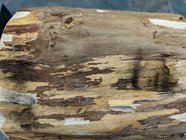I was about to put a piece of spalted maple on the lathe this morning, was planning on turning it with the bark on because the bark was pretty thin and still securely attached.
Usually I'll hit it with a wooden mallet....and see if the bark stays attached. As I hit it a couple times I saw some black mold spores release into the air. I decided to take the bark off....
So....is this mold more dangerous than sanding dust to my lungs?
I usually don't wear a mask when prepping a blank. Always wear one when sanding.
Is a normal dust mask enough to protect me from mold spores?
Safety First!
Lyle
Usually I'll hit it with a wooden mallet....and see if the bark stays attached. As I hit it a couple times I saw some black mold spores release into the air. I decided to take the bark off....
So....is this mold more dangerous than sanding dust to my lungs?
I usually don't wear a mask when prepping a blank. Always wear one when sanding.
Is a normal dust mask enough to protect me from mold spores?
Safety First!
Lyle

